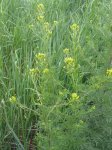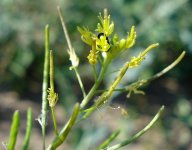Descurainia sophia - descurainia sophia l.
Family Cruciferae - Brassicaceae (Cruciferae)
Botanical characteristics. Annual herbaceous plant. Root is a rod, branched. Stalk straight, branchy, up to 80 cm high, pubescent. Leaves regular sessile, at the base with ears, pubescent. Flowers are pale yellow, collected in the scute. After the formation of fruits, a long brush is formed. Fruit is a multi-seed pod. Seeds are oval, squeezed, folded, yellowish-brown. Blossoms from May to August, fruiting till September.
Spread. It grows on pastures, in gardens, along roads, in garbage places.
Used parts of the plant. The medicinal raw materials are the aboveground part, leaves, flowers, seeds, less often roots, collected in the usual way.
Chemical composition. All parts of the plant contain saponins steroid, coumarins, alkaloids, alcohols, steroids, organic acids, cardenolides, thioglycosides, mineral salts; Leaves contain vitamins, pigments: in seeds - fatty, mustard oil.
Application. Preparations deskurainii Sofia have astringent, diuretic, exciting, antiemetic, anthelmintic, antiseptic, wound-healing property.
In folk medicine , decoctions and infusions of the aboveground part of the plant are used for colds, malaria, fever; In the Caucasus - with gastric diseases and pulmonary tuberculosis; In Central Asia - with diseases of the throat, as an antipyretic, with measles and smallpox, as hemostatic, wound-healing. Fresh juice - for washing and healing of wounds, trophic ulcers, tumors.
Desquarinia drugs are effective in the case of progressive collapse due to the weakening of the heart and as a phytoncidal agent.
In Tibetan medicine and Transbaikalia, decoctions of the aerial part are used to treat anthrax, erysipelas, with internal bleeding, as diuretic, anthelmintic, with nephrolithiasis, hysterical fits, as anti-inflammatory, for washing purulent wounds, ulcers, boils; In the medicine of the peoples of Western Europe, decoction of seeds is used for various diseases of the digestive and heart organs, arrhythmias, as wound healing.
In Indian medicine, decoction of seeds is widely used as a bitter, expectorant, with fever, bronchitis, cholelithiasis, with nervous excitation, as an antiscorbutic. Deskuraine is also a substitute for mustard.
Preparation
- To prepare the infusion, take 6 g of leaves or flowers, pour 200 ml of boiling water, insist on a boiling water bath for 15 minutes, cool for 45 minutes, filter, make up to 200 ml. Take 2 tbsp. Spoon 3 times a day after meals.
- For broth 5 g of seeds or roots are ground, poured 180 ml of boiling water, insist on a boiling water bath for 30 minutes, cool 10 minutes, filter, bring to the desired volume. Take should be 2 tbsp. Spoons 2-3 times a day after meals.
Contraindications. In the literature there is information about the virulence of plants, especially seeds. In this regard, at home, care must be taken when preparing preparations from seeds, do not exceed the dosage, store separately from other raw materials, with an inscription on the package.





Comments
When commenting on, remember that the content and tone of your message can hurt the feelings of real people, show respect and tolerance to your interlocutors even if you do not share their opinion, your behavior in the conditions of freedom of expression and anonymity provided by the Internet, changes Not only virtual, but also the real world. All comments are hidden from the index, spam is controlled.